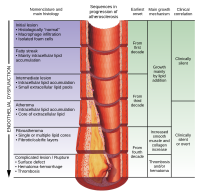
Photo from wikipedia
Background Rheumatoid arthritis (RA) is an autoimmune systemic chronic inflammatory disorder, which is characterized by joint stiffness, damage, and destruction of bone. In RA patients, the risk of cardiovascular disease… Click to show full abstract
Background Rheumatoid arthritis (RA) is an autoimmune systemic chronic inflammatory disorder, which is characterized by joint stiffness, damage, and destruction of bone. In RA patients, the risk of cardiovascular disease is increased by 2–3 folds as compared to the general population. The major burden of RA is the development of cardiovascular diseases, including congestive heart failure, stroke, and myocardial infarction. Objectives Assessment of the association of atherogenic indices with C-reactive protein to evaluate CVD risk was one of the purposes of this study. In addition, the association of atherogenic indices with elevated levels of cardiovascular risk factors (LDL-C and TG) was another aim of this study. Methods The preferred study design for this study was a hospital based comparative cross-sectional study method. Data were cleaned, coded, and entered into Epi Data version 4.6 software, and exported to SPSS version 20 for further analysis of atherogenic indices, C-reactive protein, and risk factors. The comparison of atherogenic indices and other variables among the case and control groups was estimated by the independent t-test statistical analysis method. All variables with a p-value less than 0.2 during binary linear regression analysis were selected for multinomial logistic regression analysis. The association of atherogenic indices with C-reactive protein and risk factors was computed using multiple logistic regressions. The data were presented using tables and figures for clarification of the study. Results The levels of atherogenic indices were computed for both RA patients and the control group. The values of atherogenic indices were significantly associated with cardiovascular risk factor (CRP ≥ 2mg/L). Atherogenic index of plasma (AIP) and TC/HDL-C ratio had a statistically significant association with an elevated levels of triglycerides (P<0.01). The TC/HDL-Cratio value of the patient had 2.38 folds more likely to have an elevated low density lipoprotein level. In addition, AIP of RA patients had 57.51 and 23.65 folds more to have elevated low density lipoprotein and triglycerides respectively. Conclusions The result of this study showed that TC/HDL-C, LDL/HDL-C ratio values, and atherogenic index of plasma had a statistically significant association with elevated level of low density lipoprotein and triglycerides. In addition to this, they have a statistically significant association with the level of C-reactive protein. There was a highly significant statistical association between atherogenic indices, elevated low density lipoprotein, and triglycerides values. Therefore, the result of this finding confirmed that atherogenic indices have a potential role in the prediction and management of CVD risk in RA patients.
Journal Title: PLoS ONE
Year Published: 2022
Link to full text (if available)
Share on Social Media: Sign Up to like & get
recommendations!